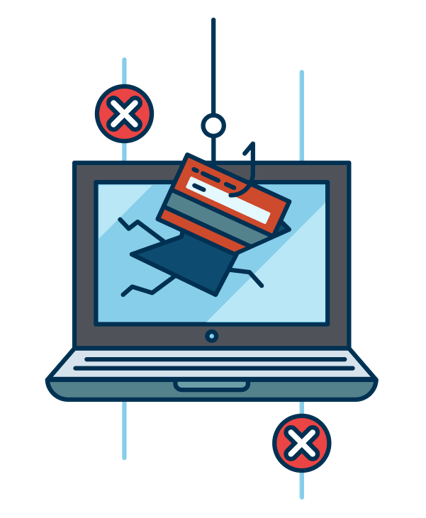By Ashley Lukehart (Tech Writer & Entrepreneur)
The internet, the cloud, and the internet of things are here to stay and have completely changed how we work and communicate. Companies of all sizes (and even toasters) use the cloud and the internet daily to store data, communicate with users, employees, or clients, and complete essential tasks. While the cloud and the internet offer plenty of benefits, they also put your IT company, employees, and clients at risk for cyber attacks.
Luckily, you can take steps to protect your IT or MSP company from the most common cyber threats. Cyber attacks can damage your company's reputation and compromise your customer's safety and recovering from a cyber attack can also be very expensive. So implementing cybersecurity best practices today is an investment in your IT & MSP company's future. Here are five of the most common cyber attacks and how to prevent them.
Malware
Malware is a broad term that refers to any type of software that is made with malicious intent. This broad category of cyber attacks includes viruses, spyware, and more. In most cases, users accidentally download these software programs without realizing it by clicking on a link or opening an email attachment from an untrustworthy source. Malware programs can covertly collect sensitive information from your computer, and they can also prevent your systems from running properly.
The first step to preventing malware attacks is to train your team on cybersecurity best practices. Most malware attacks are conducted via email, and with practice, you can learn to identify suspicious emails that could potentially be dangerous to open. Upon closer inspection, there’s usually something that’s not quite right with the subject line or sender’s email address. Beyond that, installing a reliable antivirus program across all company devices is a must. Make sure to update the antivirus program regularly and continually monitor all of your user accounts for any abnormal activity.
Ransomware
Ransomware is a specific type of malware that can cause significant financial damage to your company. Ransomware programs target valuable data, such as secure product information, customer profiles, or even financial information, and restrict access to it. The most sophisticated forms of ransomware will encrypt this data, making it even more difficult to access. Hackers will then charge a (often exorbitant) fee to get your data back.
Hackers often use ransomware to target larger companies, but anyone can fall victim to a ransomware attack. A sophisticated antivirus program can help prevent ransomware attacks, but it’s important to remain vigilant. Have a contingency plan in place for what to do in the event of a ransomware attack. It’s also important to back up key pieces of data at regular intervals and invest in system monitoring.
Phishing
Phishing is another type of cyber attack that is extremely common, and it can happen to any business or individual. In a phishing attack, the hacker pretends to be a trusted contact or organization. For example, many phishing attacks will mimic communications from companies like Google or Facebook. These attacks usually happen via email or social media platforms and look legitimate, but will collect your financial or personal information for malicious purposes. Some hackers even direct these attacks at specific companies (spear phishing) or even specific executives (whaling).
The most effective way to prevent phishing attacks is to keep your team informed. Hackers have become increasingly sophisticated with their phishing attempts over the years. Regular training sessions about the latest phishing attacks can help prevent these issues from happening. Many cybersecurity software programs also have tools that will identify and filter out phishing emails and messages.
DDoS Attacks
Distributed denial of service (DDoS) attacks are often targeted at companies that provide services online. In a DDoS attack, hackers overload your servers to take your entire network offline. There are many different types of DDoS attacks, but all of them can cause significant damage to your company. These attacks are typically conducted using botnets, which are networks of computers and other electronic devices that are infected with malware. The malware allows the hacker to control all of these devices at once and flood the target network with requests.
DDoS attacks have become more common over the last few years, so it’s very important to stay vigilant and protect your networks. The best way to prevent DDoS attacks is to configure your networks in a way that makes them difficult to penetrate. This often means siloing some of your data, switching to cloud-based data storage, or adding more network bandwidth, depending on your individual situation. It’s also important to make sure your entire team is using cybersecurity best practices, and to have a contingency plan in place should a DDoS attack go through.
SQL Injection
A structured query language injection (SQL) happens when a hacker puts malicious code into your server. This normally happens through unsecured search bars, comment boxes, or chat features. This malicious code allows hackers to access secure or sensitive data.
To prevent SQL injections, you’ll need to make sure you’re using secure code when building your website. Some website-building tools already have secure code implemented, but it’s always helpful to double-check before making the site live.
Preventing Cyber Attacks
Regardless of what type of cyber attack you are trying to prevent, there are security best practices that every company can follow. Every network user should have a complex password that uses letters, numbers, and special characters. These passwords should be updated at regular intervals and strengthened with two-factor authentication whenever available.
Whenever possible, your team should work from designated professional devices rather than personal devices and use secure WiFi networks. This can be tricky to do with so many people working from home, but it’s worth taking the extra steps to keep the entire team secure. You may also want to consider outsourcing some of your IT and security services as your company grows. Cybersecurity threats are consistently evolving and changing, and your systems need to be consistently monitored for abnormalities. Outsourcing these services to an MSP that is also a security specialist gives you more time to focus on growing your business.








comments